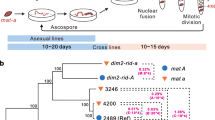Abstract
Repeat-induced point mutation (RIP) is a hypermutational process that alters duplicated DNA sequences in Neurospora crassa. In previous studies, five of six large (>100 kb) chromosome segment duplications (Dp’s) examined were shown to dominantly suppress RIP in smaller (<5 kb) duplications. The suppressor duplications were >270 kb, whereas the lone non-suppressor duplication was ∼117 kb. We have now screened another 33 duplications and found 29 more suppressors and four more non-suppressors. All 22 suppressor duplications whose size could be estimated were >270 kb, whereas two newly identified non-suppressor duplications examined were 140–154 kb. RIP was suppressed in a subset of crosses heterozygous for more than one ordinarily non-suppressor duplication. These results strengthen the hypothesis that large duplications titrate out the RIP machinery and suggest the “equivalence point” for the titration is close to 300 kb.
Similar content being viewed by others
References
Bhat A, Kasbekar DP (2001) Escape from repeat-induced point mutation of a gene-sized duplication in Neurospora crassa crosses that are heterozygous for a larger chromosome segment duplication. Genetics 157:1581–1590
Bhat A, Kasbekar DP (2004) Why are Neurospora crassa crosses that are homozygous for a large duplication barren? Fungal Genet Newslett 51:15–16
Bhat A, Noubissi FK, Vyas M, Kasbekar DP (2003) Genetic analysis of wild-isolated Neurospora crassa strains identified as dominant suppressors of repeat induced point mutation. Genetics 164:947–961
Butler DK, Metzenberg RL (1990) Expansion and contraction of the nucleolus organizer region of Neurospora: changes originate in both proximal and distal segments. Genetics 126:325–333
Davis RH, De Serres FJ (1970) Genetic and microbiological research techniques for Neurospora crassa. Methods Enzymol 17:79–143
Fehmer M, Bhat A, Noubissi FK, Kasbekar DP (2001) Wild-isolated Neurospora crassa strains that increase fertility of crosses with segmental aneuploids used to establish that a large duplication suppresses RIP in a smaller duplication. Fungal Genet Newslett 48:13–14
Galagan JE, Selker EU (2004) RIP: The evolutionary cost of genome defense. Trends Genet 20:417–423
Lee DW, Seong. KY, Pratt RJ, Baker K, Aramayo R (2004) Properties of unpaired DNA required for efficient silencing in Neurospora crassa. Genetics 167:131–150
Noubissi FK, McCluskey K, Kasbekar DP (2000) Repeat-induced point mutation (RIP) in crosses with wild-isolated strains of Neurospora crassa: evidence for dominant reduction of RIP. Fungal Genet Biol 31:91–97
Perkins DD (1997) Chromosome rearrangements in Neurospora and other filamentous fungi. Adv Genet 36:239–398
Perkins DD, Margolin BS, Selker EU, Haedo SD (1997) Occurrence of repeat-induced point mutation in long segmental duplications of Neurospora. Genetics 114:729–736
Perkins DD, Freitag M, Pollard VC, L Bailey-Shrode A, Selker EU, Ebbole DJ (2007) Recurrent locus-specific mutation resulting from a cryptic ectopic insertion in Neurospora. Genetics 175:527–544
Prakash A, Sengupta S, Aparna K, Kasbekar DP (1999) The erg-3 (sterol Δ14, 15 reductase) gene of Neurospora crassa: generation of null mutants by repeat-induced point mutation and complementation by proteins chimeric for human lamin B receptor sequences. Microbiology 145:1443–1451
Shiu PK, Raju NB, Zickler D, Metzenberg RL (2001) Meiotic silencing by unpaired DNA. Cell 107:905–916
Shiu PK, Metzenberg RL (2002) Meiotic silencing by unpaired DNA: properties, regulation and suppression. Genetics 161:1483–1495
Shiu PK T, Zickler D, Raju NB, Ruprich-Robert G, Metzenberg RL (2006) SAD-2 is required for meiotic silencing by unpaired DNA and perinuclear localization of SAD-1 RNA-directed RNA polymerase. Proc Natl Acad Sci USA 103:2243–2248
Smith ML, Glass NL (1996) Mapping translocation breakpoints by orthogonal field agarose gel electrophoresis. Curr Genet 29:301–305
Vyas M, Ravindran C, Kasbekar DP (2006) Chromosome segment duplications in Neurospora crassa and their effects on repeat-induced point mutation (RIP) and meiotic silencing by unpaired DNA. Genetics 172:1511–1519
Watters MK, Randall TA, Margolin BS, Selker EU, Stadler DR (1999) Action of repeat-induced point mutation on both strands of a duplex and on tandem duplications of various sizes in Neurospora. Genetics 153:705–714
Acknowledgements
Mukund Ramakrishnan provided assistance in some of the experiments. We thank Bob Metzenberg for sending us strains. Charges for strains obtained from the Fungal Genetics Stock Center (FGSC) were generously waived. The FGSC is supported by National Science Foundation grant BIR-9222772. PKS was supported by a Research Fellowship from the CSIR-UGC.
Author information
Authors and Affiliations
Corresponding author
Additional information
This article is dedicated to the memory of Robert L. Metzenberg.
Electronic supplementary material
Below is the link to the electronic supplementary material.
Rights and permissions
About this article
Cite this article
Singh, P.K., Kasbekar, D.P. Titration of repeat-induced point mutation (RIP) by chromosome segment duplications in Neurospora crassa . Genetica 134, 267–275 (2008). https://doi.org/10.1007/s10709-007-9234-6
Received:
Accepted:
Published:
Issue Date:
DOI: https://doi.org/10.1007/s10709-007-9234-6




